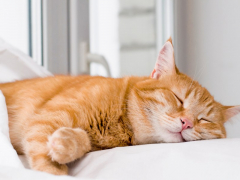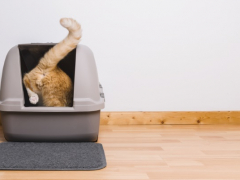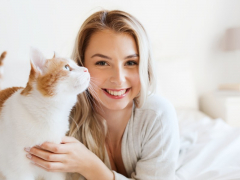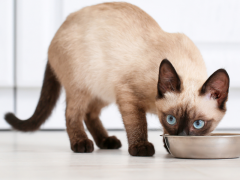
Andrey Tairov / Shutterstock.com
Cats come in all shapes, sizes, and appearances. All of these differences make them endearing to us and have led to the development of many cat breeds all over the world. Ultimately everything that makes one cat different from another is a difference in the makeup of their genes, their DNA.
Genetic mutation could be thought of as a more pronounced expression of one or more of these differences, whether it’s related to physical appearance or health. In this article, you’ll learn a little about what genetic mutation is, common mutations seen in cats, when genetic mutation is associated with disease in cats, and how you can screen your cat for genetic mutations they have.
What is a Genetic Mutation?

Genetic mutation is caused by a change in a gene sequence along a strand of DNA. Natali_Mis / Shutterstock.com
Mutation is a word with a very bad connotation in our society, often highlighting mental images of monsters and experiments gone wrong. It may also be thought of as a subject reserved for superhero movies. But genetic mutation is at its core a simple thing: a change in the DNA sequence of any living organism.
A genetic mutation may be harmless, it may promote an advantage for survival, or it may contribute to disease. Pop culture often takes the simple idea of genetic mutation to an extreme where in reality, it does not lead to horrific monstrous creations and does not bestow super powers.
Every living thing is made of DNA. Genes are smaller segments made of DNA that contain instructions for making specific proteins. Many genes also control other genes instead of making proteins.
All in all, there are roughly 20,000 genes in the cat genome. This is very similar to humans. In 2003, the Human Genome Project reached its completion. This set the stage for mapping the genome for other species like cats, where full genome mapping occurred roughly ten years later.
Mapping the full genome allows an understanding of what genes control what traits in the body and a better understanding of what differences in the genome from one individual to the next lead to disease.
A mutation is simply a change in the DNA sequence within a gene. Mutations can contribute to changes in appearance like different hair/coat color, extra toes like we see in polydactyl cats, the absence of a tail in the Manx breed, or folded ears like we see in the Scottish Fold. Mutation can also lead to diseases, such as polycystic kidney disease (PKD) or hypertrophic cardiomyopathy (HCM). While less visible, we also know that genetic mutation can affect life span, ability to resist disease, behavior, and many other traits.
Genomic mapping since the turn of the century has allowed for specific mutations to be identified, gaining a better appreciation for why individuals look and behave the way they do and who are at risk for certain diseases.
What Causes Genetic Mutations in Cats?

Manx cats carry the tailless gene (T, t), as one example of a genetically inherited mutation. slowmotiongli / Shutterstock.com
Genetically Inherited Mutations
Genetic mutation can occur in multiple ways. The mutations we discuss in this article are due mostly to heritable genetic mutations, or those that are passed down from parents to offspring.
With these types of mutations, which are called germline mutations, a kitten will get a pair of genes, one from each parent. Each gene can be considered a dominant gene or recessive gene and a kitten may receive either from each parent.
A dominant gene is expressed as a capital letter while a recessive gene is expressed as a lowercase letter. The pair of these genes for a particular trait are called alleles. For a particular genetic trait, a cat may have two dominant alleles, one dominant and one recessive allele, or two recessive alleles.
In a case where a cat carries one or both dominant alleles for a particular trait, that trait will be expressed. The only case where a recessive gene is expressed is if both alleles are recessive.
Because this can be a mindbender, here’s an example, using the Manx cat. Manx cats carry the M gene (also called the Tailless gene, or T), which is a dominant gene contributing to a short or absent tail. The recessive gene, m (or t), can be considered a normal gene for a normal tail length.
Manx cats who receive one dominant gene and one recessive gene (Mm) while have a very short to absent tail. Cats who receive both recessive genes (mm) will have a normal length tail). Cats that receive both dominant genes (MM) will have no tail and often severe secondary health issues related to spinal cord and vertebral malformations.
Naturally, there are ethical concerns associated with cats bred to have the MM alleles, as they often have issues affecting their quality of life and a shortened life span. These types of effects can be seen with most genetically inherited traits, leading some states and countries to make intentional breeding of certain appearance traits illegal.
It’s also important to realize that genes can be linked to other genes. This means that selecting for one gene controlling a certain appearance trait in a breeding program may inadvertently lead to also selecting for a less desirable genetic trait at the same time.
Cellular Mutations
We know that genes can also be “turned” on and off, a very complex thing to think about with genes that make proteins being controlled by other genes.
Mutation can occur at the DNA level within cells of the body, something called somatic mutation. This is different from heritable mutations that occur in eggs and sperm being passed on at conception.
Somatic mutation in cells can occur for a multitude of reasons including errors in DNA replication when cells divide, infections with viruses, and exposure to mutagens.
A mutagen is anything that changes the DNA makeup of a cell. Mutagens can include chemicals and radiation and lead to diseases like cancer. Certain drugs, foods, and carcinogens like tobacco products contain mutagens. Even exposure to the sun’s radiation can cause changes in cells enough to cause cancers like squamous cell carcinoma.
These somatic mutations are so various and affected by so many factors. The best way to approach these types of topics is to learn about a certain disease process (like squamous cell carcinoma for example) and what has been discovered specifically about that disease in terms of genetic mutation that may be involved (such as repeated sun exposure in cats with light coats and poor pigmented areas).
The following mutations we’ll discuss more are defined more as ones caused by a single known gene mutation, especially passed down at birth.
Common Genetic Mutations in Cats

Polydactyly (extra toes) is a common and generally harmless genetic mutation that is commonly seen in cats. Mary Swift / Shutterstock.com
There are many very common genetic mutations in cats that lead to a change in their appearance. Some of these changes are neither good nor bad, while others may contribute to secondary health effects.
While we will highlight some of the more common mutations, there are too many to discuss all of them. For more detailed lists of mutations and the differences they contribute to, you can refer to The University of Missouri’s Cat Genetic Mutations Table and DNA mutations of the cat: The good, the bad, and the ugly.
Next to each genetic mutation is also listed both the dominant and recessive abbreviations for the mutation itself and the gene involved (if known).
1. Polydactyly (Pd, pd/5HH)
Polydactyly is the medical term for an individual with extra toes. Colloquially, we refer to polydactyl cats as having extra “toe beans” or baseball mitts. Most polydactyl cats don’t have more than two extra toes, for a total of 6 or 7 on the front feet and 5-6 on the back. In many cats, only the front feet are affected, but any of the four feet can have extra digits.
Polydactyly is thought to have originated as a way for cats in the wild to be able to have better grip or traction or to be better hunters.
There are a few significant concerns associated with polydactyly, though it can lead to misshapen toes.
2. Long fur (L, l/FGF5)
Long fur has some different variations in different parts of the world, involving variations in the gene fibroblast growth factor 5 (FGF5). Examples of cats expressing these genes include Ragdolls, Persians, Norwegian Forest Cats, and Maine Coons.
3. No fur/hairlessness (Hr, hr/KRT71)
On the flip side of our long-haired cats, we also have cats with minimal or no hair, like the Sphynx. Other breeds with the same genetic makeup include the Bambino, Dwelf, and Elf. The Peterbald breed, while appearing similar, has its own specific gene. While hairlessness in cats is a naturally occurring gene, cats like the Sphynx were bred intentionally around the mid-20th century.
4. Dwarfism (Mk, mk)
Dwarfism specifically means having shortened long bones. The breed of note is the Munchkin. Cats with one dominant and one recessive allele will have shortened legs. However, short-legged cats carrying both dominant alleles can have severe disorders of bone and cartilage growth (osteochondrodysplasia).
They can also suffer from back and spinal disorders. For this reason, intentionally breeding cats in this manner may be illegal in some places.
5. Folded ears (Fd, fd)
The Scottish fold is the primary breed where this trait is seen. While a naturally occurring genetic trait, the Scottish fold appearance was intentionally developed with selective breeding in the mid to late 20th century starting in (you guessed it) Scotland.
Cats with two copies of the gene can also develop disorders of bone and cartilage, similar to dwarf breeds, making this type of intentional breeding discouraged or illegal. Cats with one copy still have folded ears and are less likely to develop other bone and cartilage disorders.
6. White coated cats (W, w/KIT)
A cat with a white coat is not the same as an albino cat. The W gene is dominant, so any cat carrying a W gene will be white, regardless of the recessive coat color gene also present. Cats with two copies of the W gene have been documented to be at a much higher risk of deafness.
Albinism, which is rare but can be seen in any animal, involves complete lack of melanin pigment in the hair, skin, and eyes. Genetically, albinism is most often associated with a mutation in the tyrosinase (TYR) gene.
7. Short tail/no tail (M/T, m/t/TBOX) and (J/Jb, j/jb)
There are two variations of genes causing a short or absent tail in cats. We’ve already briefly mentioned the Manx (M) or tailless (T) gene seen predominantly in Manx cats. There is also the Jb or J gene seen in the Japanese Bobtail.
In the Manx cat, the extremely short or absent tail is actually caused by a shortened and malformed vertebral column and spinal cord. This is why cats carrying two copies of the dominant gene develop severe spinal cord and vertebral defects. These effects, known as Manx syndrome, can include abnormal walking/gait, and urinary and fecal incontinence. Malformations can be so severe that kittens may die in utero or be euthanized at an early age.
In contrast, the J/Jb gene is considered more of a curled or kinked tail gene. These cats typically have a little bit more of a tail present that is curled into a kinked or knotted shape. Unlike the Manx or tailless gene, the bobtail gene is not associated with skeletal disorders.
8. Coat coloration
Coat coloration is a really broad topic in cats. In many cases, there is not a single gene affecting coat color, but a combination. A great example includes oriental breeds like the Siamese and Balinese, which have different degrees of color dilution and the appearance of their fur.
But a couple of great genetic mysteries involving coat color are tortoiseshell (orange and black) cats, calico (orange, black, and white) cats and orange cats.
Calico and tortoiseshell cats are almost always female while orange cats are almost exclusively male. Why? This has to do with something called sex-linked traits. Coat color is almost exclusively linked to the X chromosome, which many think of as the female chromosome (with the Y chromosome being the male chromosome).
Females have two X chromosomes, so they can inherit both black and orange coat color combinations. Each cell in the skin responsible for coat color can essentially “choose” which color to express, only being required to express one of the two X chromosomes. This leads to the patchy colored appearance of calicos and tortoiseshells.
The only case where a male cat may have a calico or tortoiseshell appearance is if they’re born with an extra X chromosome. This is not only rare but is associated with sterility in males and a shortened life span.
The orange coat color in male cats is explained by male cats getting only one X chromosome. Unlike females who will always receive two X chromosomes, the single X male orange cats receive only codes for a single color. Their cells don’t have a choice of which color to express.
Disease-Causing Genetic Mutations in Cats

Maine Coon cats are one breed known to be genetically predisposed to hypertrophic cardiomyopathy, the most common heart disease seen in cats. Parfenish_579 / Shutterstock.com
It is possible for genetically inherited mutations to directly cause disease. There are many genetic disorders that exist, but we’ll discuss the two that we see most commonly.
1. Hypertrophic cardiomyopathy (HCM)
Hypertrophic cardiomyopathy is the most common heart disease seen in cats. Interestingly, it is not controlled by just a single gene mutation in all cats. A combination of mutations may be responsible, but three genes where these occur are called cardiac myosin binding protein c (MYBPC3), B-myosin heavy chain (B-MHC or MYH7) genes, and Alstrom syndrome protein 1 (ALMS1).
In Maine Coon cats, where genetic inheritance of HCM was first discovered in the late 1990s, the mutation occurs on the MYBPC3 gene in a particular location, which only occurs in Maine Coons.
In Ragdolls, the mutation occurs on the same gene, but in an entirely different location.
In Sphynx cats, a mutation at the ALMS1 gene is thought to be the cause in a majority of Sphynx cats with HCM, though this gene mutation was also more recently found in a couple of other cat breeds (Munchkin and Scottish Fold) and may not be exclusive to them.
A more recent mutation called the A3P1 mutation on the MYBPC3 gene has been described as well.
The B-MHC/MYH7 gene appears to be more rarely expressed but may be associated with more severe disease in affected cats, whereas mutations on the MYBPC3 gene may be associated with later onset disease.
Other cat breeds predisposed to HCM include the British Shorthair, British Longhair, Persian, Burmese, and Chartreux.
In domestic cats, the genetic basis for HCM is far more variable. At least 6 different genetic mutations on 4 different genes have been linked to HCM in non-purebred cats.
2. Polycystic Kidney Disease (PKD)
In contrast to HCM, polycystic kidney disease is caused by a mutation in only one place, on the PKD1 gene. This mutation was found to be responsible for over 80% of cats affected by PKD, predominantly in Persian cats. Ragdolls were also overrepresented as a breed, as Ragdolls may be bred to Persians.
Fortunately, polycystic kidney disease can be diagnosed reliably using ultrasound. With ultrasound becoming more common in veterinary practice, responsible breeders have been able to remove affected cats from their breeding program reducing the number of cats with the condition.
Testing for Genetic Mutations in Cats
With the cat genome fully mapped, it is entirely possible now to easily order genetic tests to determine what kind of genetic makeup your cat may have.
Two examples of companies that provide home test kits include Basepaws and the Wisdom Panel. By tying breed-associated diseases to your cat’s genetic makeup, the panels can help assess your cat’s risk for certain genetically-inherited diseases.
For specific genetically-associated disorders like hypertrophic cardiomyopathy and polycystic kidney disease, specific veterinary colleges offer genetic testing.
UC Davis offers a genetic test for polycystic kidney disease.
For hypertrophic cardiomyopathy, there are a couple of different breed-specific tests given that different breeds have mutations at different genes or gene locations.
UC Davis and NC State both offer breed-specific genetic testing for HCM:
- UC Davis HCM testing for Ragdolls
- NCState HCM testing for Ragdolls
- UC Davis HCM testing for Maine Coons
- NCState HCM testing for Maine Coons
- NCState HCM testing for Sphynx
-
Wikimedia Foundation, Inc. (2025, January 12). List of cat body-type mutations. Wikipedia.
-
Leeson, J. (2024, July 28). 9 Fascinating Genetic Anomalies in Cats. petMD.
-
Lyons, L. A. (2015). DNA mutations of the cat. Journal of Feline Medicine and Surgery, 17(3), 203–219. https://doi.org/10.1177/1098612x15571878
-
Body Type Mutations in Cats. (2019, July 30). Basepaws Pet Genetics.
-
Inherited disorders in cats. (2024, October 28). International Cat Care.
-
Cat Genetic Mutations 05 April 2020 (Public) Table 1. (2020, April 5). University of Missouri College of Veterinary Medicine.
-
National Human Genome Research Institute. (2025, January 22). Mutation. Genome.gov.
-
NHGRI. (2019, March 13). Human Genome Project Timeline. Genome.gov.
-
NCI Dictionary of Cancer Terms. (n.d.). Cancer.gov.
-
Libretexts. (2023, June 20). 6.3: example of multiple genes affecting one character. Biology LibreTexts.
-
Reardon, S. (2024, November 24). Gene behind orange fur in cats found at last. Science.
-
Stern, J. A., Rivas, V. N., Kaplan, J. L., Ueda, Y., Oldach, M. S., Ontiveros, E. S., Kooiker, K. B., Van Dijk, S. J., & Harris, S. P. (2023). Hypertrophic cardiomyopathy in purpose-bred cats with the A31P mutation in cardiac myosin binding protein-C. Scientific Reports, 13(1). https://doi.org/10.1038/s41598-023-36932-5
-
Lyons, L. A., Biller, D. S., Erdman, C. A., Lipinski, M. J., Young, A. E., Roe, B. A., Qin, B., & Grahn, R. A. (2004). Feline Polycystic kidney Disease mutation identified in PKD1. Journal of the American Society of Nephrology, 15(10), 2548–2555. https://doi.org/10.1097/01.asn.0000141776.38527.bb
-
Hypertrophic cardiomyopathy. (n.d.). Cornell University College of Veterinary Medicine.
-
Akiyama, N., Suzuki, R., Saito, T., Yuchi, Y., Ukawa, H., & Matsumoto, Y. (2023). Presence of known feline ALMS1 and MYBPC3 variants in a diverse cohort of cats with hypertrophic cardiomyopathy in Japan. PLoS ONE, 18(4), e0283433. https://doi.org/10.1371/journal.pone.0283433
-
E Katherman, A. (2023, May 16). Manx Syndrome in Cats. Veterinary Partner.







